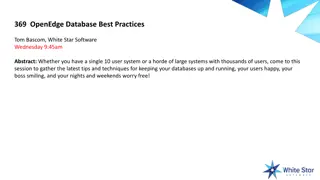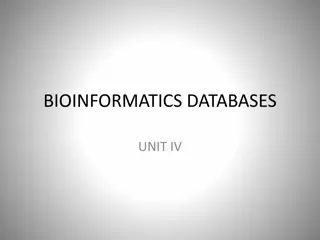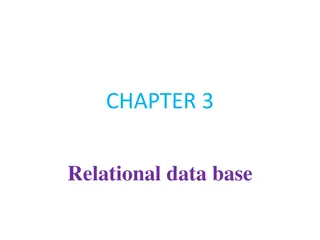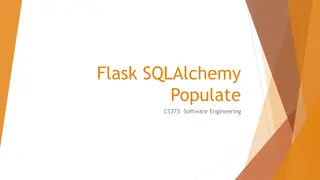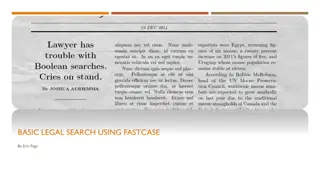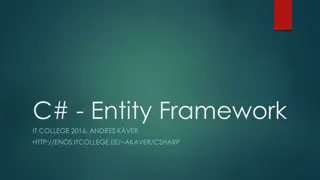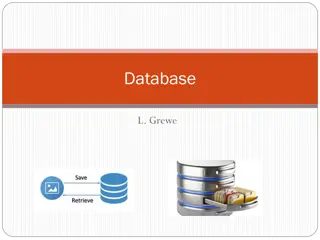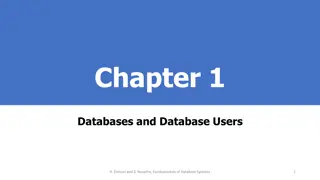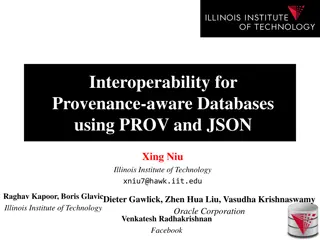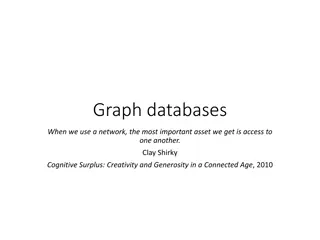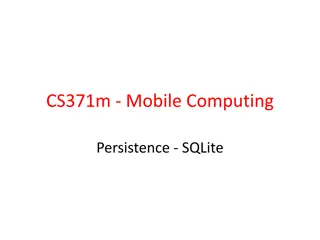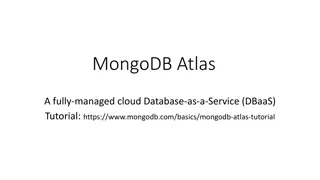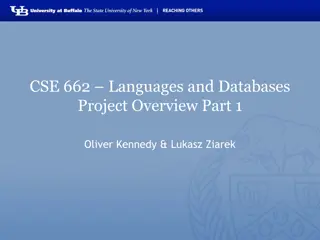Understanding Databases and Database Applications
Databases are collections of related data used to store known facts with implicit meanings in a structured manner. A Database Management System (DBMS) is crucial in managing databases efficiently by defining structures, loading data, manipulating content, ensuring security, and facilitating data access and sharing. Explore the basic definitions, simplified system environments, typical functionalities, and examples of databases in various real-world scenarios.
Download Presentation

Please find below an Image/Link to download the presentation.
The content on the website is provided AS IS for your information and personal use only. It may not be sold, licensed, or shared on other websites without obtaining consent from the author. Download presentation by click this link. If you encounter any issues during the download, it is possible that the publisher has removed the file from their server.
E N D
Presentation Transcript
Database & Database Applications INTRODUCTION: DATABASES AND DATABASE USERS
Outline Basic Definitions Simplified database system environment Typical DBMS Functionality Example of a Database(Some mini-world relationships) Main Characteristics of the Database Approach Database Users Advantages of Using the Database Approach When not to use a DBMS !!!
Basic Definitions Database: Database: A collection of related data. Data: Data: Known facts that can be recorded and have an implicit meaning. Mini Mini- -world: world: Some part of the real world about which data is stored in a database. For example, student grades and transcripts at a university. Database Management System (DBMS): Database Management System (DBMS): A software package/ system to facilitate the creation and maintenance of a computerized database. Database System: Database System: The DBMS software together with the data itself. Sometimes, the applications are also included.
Typical DBMS Functionality 1. 1. Define: Define: a particular database in terms of its data types, structures, and constraints Construct or Load Construct or Load Construct or load the initial database contents on a secondary storage medium Manipulating the database: Manipulating the database: Retrieval: Querying, generating reports Modification: Insertions, deletions and updates to its content Accessing the database through Web applications Processing and Sharing Processing and Sharing Processing and sharing by a set of concurrent users and application programs yet, keeping all data valid and consistent Protection or Security Protection or Security Presentation and Visualization of data Presentation and Visualization of data Maintaining the database and associated programs over the lifetime of the database application. Maintaining the database and associated programs over the lifetime of the database application. 2. 2. 3. 3. 4. 4. 5. 5. 6. 6. 7. 7.
Example of a Database(Some mini-world relationships) SECTIONs are of specific COURSEs STUDENTs take SECTIONs COURSEs have prerequisite COURSEs INSTRUCTORs teach SECTIONs COURSEs are offered by DEPARTMENTs STUDENTs major in DEPARTMENTs
Main Characteristics of the Database Approach 1. 1. Self Self- -describing describing nature system system: : A DBMS stores the description of a particular database (e.g. data structures, types, and constraints) This allows the DBMS software to work with different database applications. nature of of a a database database catalog catalog (A.K.A meta meta- -data data) 2. 2. Insulation Insulation between (A (A. .K K. .A A program program- -data Allows changing data structures and storage organization without having to change the DBMS access programs. between programs data independence) independence): : programs and and data data
Main Characteristics of the Database Approach 3 3. Data Abstraction . Data Abstraction A data model data model is used to hide storage details and present the users with a conceptual view of the database. 4. Support of multiple views of the data Support of multiple views of the data Each user may see a different view of the database, which describes only interest to that user. 5. Sharing of data and multi Sharing of data and multi- -user transaction processing user transaction processing Allowing a set of concurrent users concurrent users to retrieve from and to update the database. only the data of
Database Users 1. 1. Actors on the Scene Actors on the Scene Those who use and control the database content, and those who design, develop and maintain database applications 2. 2. Workers Behind the Scene Workers Behind the Scene Those who design and develop the DBMS software and related tools, and the computer systems operators
Actors on the scene 1. 1. Database administrators Database administrators Responsible for authorizing access to the database 2. 2. Database Designers Database Designers Responsible to define the content, the structure, the constraints, and functions or transactions against the database. They must communicate with the end-users and understand their needs. 3. 3. End End- -users : users : They use the data for queries, reports and some of them update the database content. End-users can be categorized into: 1. 1. Casual Casual: access database occasionally when needed 2. 2. Na ve Na ve or Parametric: they make up a large section of the end-user population. 3. 3. Sophisticated Sophisticated These include business analysts, scientists, engineers, others thoroughly familiar with the system capabilities 4. 4. Stand Stand- -alone alone Mostly maintain personal databases using ready-to-use packaged applications
Workers behind the Scene 1. 1. DBMS system designers and implementers DBMS system designers and implementers 2. 2. Tool developers Tool developers 3. 3. Operators and maintenance personnel Operators and maintenance personnel
Advantages of Using the Database Approach 1. Controlling redundancy in data storage and in development and maintenance efforts. 2. Restricting unauthorized access to data. 3. Providing persistent storage for program Objects 4. Providing Storage Structures (e.g. indexes) for efficient Query Processing 5. Providing backup and recovery services. 6. Providing multiple interfaces to different classes of users. 7. Representing complex relationships among data. 8. Enforcing integrity constraints on the database. 9. Drawing inferences and actions from the stored data using deductive and active rules
When not to use a DBMS !!! Main inhibitors (costs) of using a DBMS: High initial investment and possible need for additional hardware. Overhead for providing generality, security, concurrency control, recovery, and integrity functions. When a DBMS may be unnecessary: 1. If the database and applications are simple, well defined, and not expected to change. 2. If there are stringent real-time requirements that may not be met because of DBMS overhead. 3. If access to data by multiple users is not required. When no DBMS may suffice: If the database system is not able to handle the complexity of data because of modeling limitations If the database users need special operations not supported by the DBMS.
Summary Types of Databases and Database Applications Basic Definitions Typical DBMS Functionality Example of a Database (UNIVERSITY) Main Characteristics of the Database Approach Database Users Advantages of Using the Database Approach When Not to Use Databases



